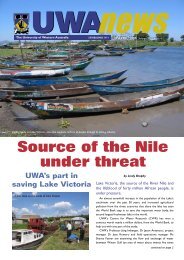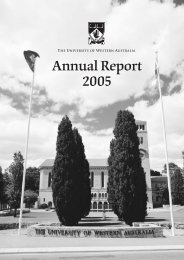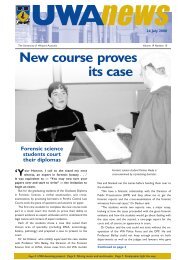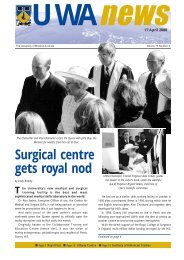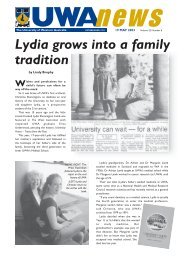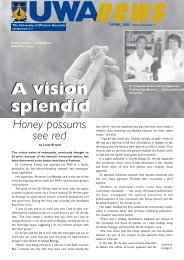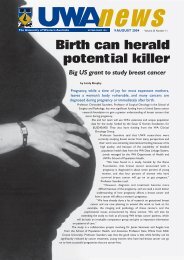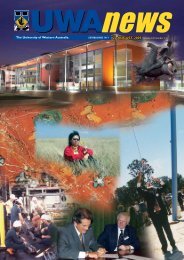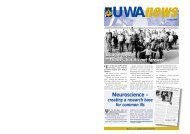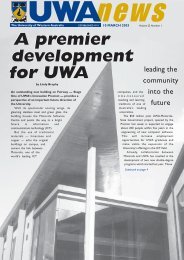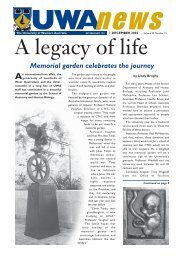28 Aug : Vol 25, #12 - UWA News staff magazine - The University of ...
28 Aug : Vol 25, #12 - UWA News staff magazine - The University of ...
28 Aug : Vol 25, #12 - UWA News staff magazine - The University of ...
- No tags were found...
You also want an ePaper? Increase the reach of your titles
YUMPU automatically turns print PDFs into web optimized ePapers that Google loves.
<strong>UWA</strong>news<strong>The</strong> <strong>University</strong> <strong>of</strong> Western Australia ESTABLISHED 1911<strong>28</strong> AUGUST 2006 volume <strong>25</strong> Number 12<strong>The</strong> busy hospital operatingtheatre with surgeons, nursesand anaesthetists jostling forroom around the table maybecome a scene from thepast.Surgeonswon’t get theirhands on patientsLEFT: Neville Veitch,who had roboticsurgery on hisprostate cancer,with CTEC director,A/Pr<strong>of</strong>essor BernardLaurence“I was out <strong>of</strong> hospital two days after surgeryand three days later I was swimming”NEVILLE VEITCH, TREATED BY THE DA VINCI SYSTEMSurgery <strong>of</strong> the future is likely tobe conducted by a medical specialistconcentrating on a computer screen,metres away from the patient on theoperating table.Robotic surgery was demonstrated toabout 40 practitioners recently at <strong>UWA</strong>’sClinical Training and Education Centre(CTEC).<strong>The</strong> da Vinci surgical system is in usein North America and Europe and thereare four da Vinci robots in hospitals in theeastern states.This was the first opportunity forWestern Australian surgeons to try theirhand at robotic surgery. Its advantages arethat it is minimally invasive and gives thesurgeon far better vision and far greaterdexterity, especially in relatively inaccessibleareas in the chest and abdomen.<strong>The</strong> surgeon works at a console whichprovides a three dimensional view <strong>of</strong> thepart <strong>of</strong> the body being operated on. It hasexceptional clarity and magnifi cation. Fourrobotic arms with jointed wrists, capable<strong>of</strong> exceeding the natural movements <strong>of</strong>the human hand, are controlled remotelyby the surgeon.Patients benefi t from the minimallyinvasive nature and increased precision<strong>of</strong> the surgery which result in less postoperativepain, lower blood loss, leading toshorter recovery time, and earlier returnto normal activity than after conventionalprocedures.Neville Veitch, a farmer from MargaretRiver, told the surgeons <strong>of</strong> his experienceswith the da Vinci system. Mr Veitch wentto Adelaide, which has Australia’s onlyrobotic surgery system in a public hospital,for treatment for prostate cancer.continued on page 2
<strong>UWA</strong>news<strong>The</strong> campus conservation team: (REAR) Shobha Cameron, GillianLilleyman and (FRONT) Ron Bodycoat and Robyn TaylorWhat’sworthsaving?Is there a corner <strong>of</strong> theCrawley campus thathas special significancefor you?No matter how personalthe reason is, you are invitedto submit it to the Crawley Conservation team forconsideration.At the request <strong>of</strong> the Heritage Council, the Vice-Chancellor asked the team to develop a conservation planfor the campus, which includes the Park Avenue and Nedlandssites. <strong>The</strong> plan will enable physical development <strong>of</strong> the campusin the future while, in the words <strong>of</strong> the project manager,Shobha Cameron, “safeguarding all that is precious to <strong>staff</strong>,students and members <strong>of</strong> the community.”<strong>The</strong> conservation plan team is Ron Bodycoat (heritagearchitect), Robyn Taylor (historian), Gillian Lilleyman(landscape historian) and Shobha Cameron (<strong>UWA</strong> heritage<strong>of</strong>ficer).<strong>The</strong>y are seeking contributions from consultants in avariety <strong>of</strong> areas, but most importantly, they want to knowwhat <strong>staff</strong>, students, alumni and community members thinkshould be conserved.“We are interested in knowing whether there areparticular buildings or places or features <strong>of</strong> buildingsand places on campus which either have great personalsignificance for you or which you feel the <strong>University</strong> shouldregard as having heritage value,” Shobha said.“We would like you to email us a brief reason why eachplace is significant or why it should be conserved.“You may assume the Hackett Buildings (Winthrop Hall,Hackett Hall and the Administration building), the SunkenGarden, Tropical Grove, Somerville Auditorium and ShentonHouse have already been assessed as having considerableheritage significance.“If you believe there are buildings or places on campuswhich have no heritage significance or are actually intrusiveand should be removed, we would also like to know yourreason,” she said.Please email Shobha with your responses: ccmpcampus@uwa.edu.au by September 30. Youremail will be acknowledged but theteam will only contact you further ifclarification is needed.Don’t miss this rare opportunityto include your personal preferencesfor consideration in the future <strong>of</strong> thecampus.continued from page 1Robot Surgery“I was out <strong>of</strong> hospital two daysafter surgery and, three days later,I was swimming,” he told surgeons.Incontinence and impotence whichare <strong>of</strong>ten suffered by men who haveconventional prostate surgery have notbeen a problem for Mr Veitch.“I had the surgery six months agoand there were six small incision scars. Ican only just see four <strong>of</strong> them now andthey’re fading fast,” he said.His surgeon, Peter Sutherland,says he does about five operations aweek using the robot. “I could do morebut the instruments needed are veryexpensive,” he said.“It costs about $3,500 per case forthe special instruments.”Mr Sutherland said Mr Veitch wasa good example <strong>of</strong> how much betterit is for patients to be treated with therobotic system.“It doesn’t work for all procedures,especially extensive operations,” he said.“But it is fantastic for radical surgeryin early prostate cancer. Improvedaccessibility reduces the risk <strong>of</strong>developing incontinence or impotence.”<strong>The</strong> robots have also provedsuccessful with cardiac surgery whichcan be done without painful accessthrough the breast bone.CTEC director, Adjunct Pr<strong>of</strong>essorBernard Laurence, said the fasterrecovery times and shorter postoperativestays in hospital for patients<strong>of</strong> the da Vinci system had the potentialto ease pressure on overtaxedhospitals.Mr Sutherland said the surgeonsto whom he demonstrated the systemwere very enthusiastic. “I am hopefultheir energy will continue to helpthem persuade the government ora philanthropist to get the system inWA,” he said. “I was lucky. I had a veryrich person as a patient, who wrotethe multi-million dollar cheque for meabout two years ago.”<strong>The</strong> three other robotic surgicalsystems in Australia are in privateinstitutions in Melbourne (two) andSydney.A surgeon tries out the computer consoleTHE UNIVERSITY OF WESTERN AUSTRALIA • <strong>28</strong> august 2006
<strong>UWA</strong>news<strong>UWA</strong> EXPOsedAn unexpectedly glorious day set the scene foranother successful EXPO.<strong>The</strong> sun gleamed on the rain-washed campus as <strong>staff</strong> literallythrew the doors open and created a friendly welcoming feeling.Balloons bobbed everywhere and the smell <strong>of</strong> sizzling sausageswas on the air as prospective students did the rounds with theirparents and schoolmates.<strong>The</strong>y attended lectures, tried their hands at different skills,found out what the Guild was all about and went home with paperbags stuffed full <strong>of</strong> information.It was clear that some young men were thinking aboutenrolling in engineering as they watched the engineering students’racing car put through its paces, with some very tricky moves andlots <strong>of</strong> noise.A smoke ring machine, made from an old compost tumbler,was another noisy attraction outside the School <strong>of</strong> Physics.Pr<strong>of</strong>essor Alan Robson thanks all the <strong>staff</strong> who volunteeredtheir time and energy once again.THE UNIVERSITY OF WESTERN AUSTRALIA • <strong>28</strong> august 2006
4 <strong>UWA</strong>newsVice-Chancellor’scolumnWorking LifeSurvey 2006<strong>The</strong> <strong>University</strong> <strong>of</strong> WesternAustralia’s reputation forteaching, research andoperational excellence isdue in a very large part tothe quality, commitment anddedication <strong>of</strong> our <strong>staff</strong>.This is why we continue toput great emphasis on recruitingdeveloping and retaining the highestquality <strong>staff</strong>, and supporting thedevelopment <strong>of</strong> their full potential.It’s also why I’m keen for everyonein the university to embrace a ‘one<strong>staff</strong>, one <strong>University</strong>’ philosophythrough which we acknowledge thatwhile working within separate and<strong>of</strong>ten autonomous faculties, schools,centres or administrative units, we allcontribute to, and are responsible for,the performance <strong>of</strong> the <strong>University</strong>.To get our policies right weneed to listen to our <strong>staff</strong>. We needto learn about their experiencesand we need to hear their concerns.One very positive way we do thisis through the Working Life Surveywhich is conducted every threeyears. In the past we have been ableto use the results <strong>of</strong> the surveyto understand those things whichare most important to our <strong>staff</strong>and to identify areas where weneed to do more to improve theworking environment and workingexperience.<strong>The</strong> Working Life Survey alsoallows us to compare results overtime, examine trend data acrosscomparable questions and makesome national comparisons. In thisway, the results <strong>of</strong> the Working LifeSurvey are important for the futuredevelopment <strong>of</strong> the <strong>University</strong> andthe betterment <strong>of</strong> our working life.Everyone working within the<strong>University</strong> should have received acopy <strong>of</strong> the survey in recent weeks(if that’s not the case, please contactHuman Resources: Sasha Gablelish6488 3004). Our 006 survey isthe fourth since the survey wasintroduced in 1997. Over the years,we have found that the WorkingLife Survey provides the <strong>University</strong>with a very valuable insight into theviews, perceptions and experiences<strong>of</strong> <strong>UWA</strong> <strong>staff</strong>. More specifically,information from the Working LifeSurvey 006 will be used to:• help determine what needs to beimproved at <strong>UWA</strong>;• provide data on which to test thesuccess <strong>of</strong> new strategies; and• help identify issues to featurein future collective workplacebargaining.If our <strong>University</strong> is to remainat the forefront <strong>of</strong> quality in theAustralian higher education system,it is important we continue tounderstand everything we can aboutthe nature <strong>of</strong> work and the workingexperience. <strong>The</strong> Working Life Surveyalso reflects the importance this<strong>University</strong> puts on developing asupportive working environment.<strong>The</strong> survey results containa mass <strong>of</strong> useful and interestinginformation which we can all use,as individuals and within faculties,schools, centres and administrativeunits, to better understand theenvironment and to plan for change.To those who have not yetcompleted the survey, I would urgeyou to take the time to completethe questionnaire and return it toHuman Resources this week. Weneed your thoughts and advice ifwe are to continue to enrich the<strong>University</strong>’s working environment.Alan RobsonVice-ChancellorSpreadingwith love,and a boardA community health educationscheme has rural Indigenouspeople talking about nutrition,lifestyle and health.Health pr<strong>of</strong>essionals see it as a hugeleap forward for the health <strong>of</strong> Indigenouspeople in rural WA but the woman whoput it all together had to be convinced itwas worth turning into a PhD.Dr Julie Owen, the School <strong>of</strong>Population Health’s fi rst Indigenous PhD,said the idea was so simple that she didn’tthink it had enough academic rigour. Butshe was encouraged by her partner andher colleagues in the School and is nowdelighted both with her results and withthe effect her work is having in areasaround Albany, Bunbury and Narrogin.<strong>The</strong> program she devised is a culturallysensitivemode <strong>of</strong> delivering cardiovascularhealth education to Indigenous Australiansin south-west towns, using lay educators ascommunity role models.“I was working as a lecturer inAboriginal literature, art and music atEdith Cowan <strong>University</strong> and wanted toget back into health work, so I applied(successfully) for a health scholarship forAboriginal people to do project-basedresearch work in <strong>UWA</strong>’s School <strong>of</strong>Population Health,” Dr Owen said.“I became aware that communityhealth workers were not having muchsuccess getting the healthy heart messageacross to Indigenous people. So I askedsome <strong>of</strong> the people in Albany why theyTHE UNIVERSITY OF WESTERN AUSTRALIA • 8 AUGUST 006
<strong>UWA</strong>news 5the health messagetrustgameweren’t following the health worker’sadvice.“It turned out that they <strong>of</strong>tenfelt health workers were not trainedadequately, they didn’t like doctors, wereintimidated by nurses and were frightenedby hospitals.“Well, who do you trust? I asked.And the answer: Auntie Mary. She’s hada heart operation and leads a healthy life.She knows what to do. So I said: Can youtake me to meet Auntie Mary?”Dr Owen started a program to trainwomen who are ‘the aunties and grannies’in their town, to deliver the healthyheart message. She developed a kit witha National Heart Foundation videoand information, to be delivered with ahealthy lunch and followed by a boardgame that asked questions about whatthe participants had learned that morning.“It’s non-threatening and it makes somuch sense,” she said. “We all sit aroundtalking with our mothers and sisters andlearn so much from them because welove and trust them. It was obvious to methat these people would have an impactto those within their social network.”<strong>The</strong> lay educators are mentored bycommunity health workers, but they goout and run their ‘HeartAware’ parties(“like Tupperware parties,” said Dr Owen)on their own in someone’s home.“<strong>The</strong> message is getting throughto them and they feel that they areempowered to do something abouttheir own health and the health <strong>of</strong> theirfamilies,” she said.“In Narrogin, a group <strong>of</strong> Indigenouswomen have started a walking group.In Albany, some <strong>of</strong> the aunties realisedtheir potential and got together withthe people who run the local recreationcentre about the needs <strong>of</strong> theirgrandchildren. <strong>The</strong>y want them to growup healthy.”Dr Owen said she had three childrenby the time she was 4 and found herselfthinking that there must be more to lifethan dropping <strong>of</strong>f kids to sporting eventsand trying to remember if she’d taken themince out <strong>of</strong> the freezer that morning.“I was living in Adelaide when the<strong>University</strong> <strong>of</strong> South Australia set up aprogram encouraging Aboriginal people totrain as teachers, around 1979. So I tookit on and got a lot <strong>of</strong> support from othermature-age students and our tutors.“I fi nished my degree and started toteach just as my youngest, Shey, startedschool. I started as a teacher and shestarted as a student, at the same schoolon the same day. Now she is in her fourthyear <strong>of</strong> a veterinary science degree.“It works because it’s aboutlifestyle, not medication, andthat can mean somethingas simple as cutting the fat<strong>of</strong>f the chops before you putthem on the barbecue!”“From a classroom teacher, I becamea health education consultant, and movedto Darwin where I fell into a job inAboriginal Health Promotion and I knewthat was what I wanted to do. Whileworking in Darwin, I did my Masters inPrimary Health Care externally throughFlinders <strong>University</strong>, then worked in fourstates <strong>of</strong> Australia.I came to WA about 10 years agoand was living in Broome working as theAboriginal Health Promotion <strong>of</strong>fi cer, butmy partner returned to Perth, so I cametoo, and that’s when I started teaching atECU, but I was always looking for a wayback into health education.”Dr Julie Owen … training the‘aunties and grannies’“Pr<strong>of</strong>essor D’Arcy Holman gave methat opportunity and he talked me intodeveloping a proposal for Indigenous layeducators that then become the topic formy PhD.”Dr Owen hopes to get funding fromthe Heart Foundation or Healthway todevelop her kit to be used all over ruralAustralia.“It can be modifi ed to spread theword about all sorts <strong>of</strong> health issues,including diabetes and men’s specifichealth problems,” she said.“<strong>The</strong> people who have learnt to beheart-aware through this program havedone so by having fun together and nowunderstand and appreciate a message thatno doctor or nurse could have been ableto deliver as effectively.“It works because it’s about lifestyle,not medication, and that can meansomething as simple as cutting the fat <strong>of</strong>fthe chops before you put them on thebarbecue!”Dr Owen thanked her principalsupervisor, Associate Pr<strong>of</strong>essor RobDonovan (now at Curtin <strong>University</strong>), andco-supervisors Pr<strong>of</strong>essor D’Arcy Holmanand Dr Ann Larson, Director <strong>of</strong> theCombined Universities Centre for RuralHealth in Geraldton.THE UNIVERSITY OF WESTERN AUSTRALIA • 8 AUGUST 006
6 <strong>UWA</strong>newsNew neighbours enjoyextendedcampus<strong>UWA</strong> Press has a big production room onsite for the fi rst time, the Confucius Institutehas a home after being in limbo for a year,and <strong>UWA</strong> Extension can run classes duringthe daytime.Together with the Australian Music Examinations Board(AMEB), these are the new tenants in the heritage-listedformer Claremont Teachers’ College.And they are all very happy campers.“It’s been like moving from a slum to a mansion,” saidAssociate Pr<strong>of</strong>essor Terri-ann White, Director <strong>of</strong> <strong>UWA</strong>Press.“In our old premises, we were cramped, there was nopersonal space for anybody, it was noisy and we didn’t evenhave any work benches.“Now we have a fantastic big light room with hugebenches which has become a brilliant production space.“Now I feel I can really become the Director,” she said.A/Pr<strong>of</strong>essor White said the morale <strong>of</strong> the 10 <strong>staff</strong> hadlifted when they made the move from Park Avenue toClaremont. “We’re a lot more spread out now, but we didsome team building exercises before we left to ensure thataspect doesn’t change.“Everybody works really hard here. I feel we are nowbeing properly recognised for the work we do.”<strong>The</strong> Press’s downstairs neighbours, uWa extension,are also delighted with their new premises. <strong>The</strong>y have sixspacious classrooms and a big lecture theatre.“Best <strong>of</strong> all, we can now <strong>of</strong>fer daytime classes, for whichthere is certainly a demand,” said <strong>UWA</strong> Extension Director,Karen Reynolds. “At the Nedlands campus, the classroomswe used at night were used by other students during the dayso were not available. And parking would always have been aproblem for daytime extension students.”Extension’s Working Life series <strong>of</strong> classes, running from<strong>Aug</strong>ust to November are very popular, including programson accounting for non-accountants, effective negotiating skills,managing workplace performance, and the art <strong>of</strong> effectivemeetings. <strong>The</strong> highlight <strong>of</strong> the Spring School is a two-dayinternational seminar, Globalisation, Law and Justice, which willbe run at the <strong>University</strong> Club.Globalisation is creating major shifts in all areas <strong>of</strong> law.This seminar brings prominent thinkers from around theworld to help us understand the role <strong>of</strong> national law in aglobal society.For more information on the seminar and the latestcourses, please visit www.extension.uwa.edu.auRosslyn Feast, the state co-ordinator for the aMeB,said exams for students <strong>of</strong> piano, woodwind and stringinstruments were already under way, and that speech examswould begin this month.“We have three sound-pro<strong>of</strong>ed rooms for the exams andeverything is going well,” she said.Music exams are constant throughout the year fromMarch to November. <strong>The</strong> AMEB has three FTE <strong>staff</strong>.the confucius institute celebrated its fi rst birthdaywith the <strong>of</strong>fi cial launch <strong>of</strong> its new home on the Claremontcampus.THE UNIVERSITY OF WESTERN AUSTRALIA • 8 AUGUST 006
<strong>UWA</strong>news 7mission to marsa risky business<strong>UWA</strong> Press publishing manager, Janine Drakeford (centre)works on a new book with production <strong>of</strong>fi cersOlivier Breton and Linda Martin<strong>The</strong> opening <strong>of</strong> the Confucius Institute’s new home.<strong>The</strong> Vice-Chancellor, Pr<strong>of</strong>essor Alan Robson, takes part in aribbon-cutting ceremony at the Claremont campus<strong>The</strong> non-pr<strong>of</strong>it Institute runs Chinese language andculture classes and organises events that are relevant toChinese relations with WA in business, government andacademic areas.Institute Director Dr Gary Sigley said next year would bea signifi cant one for the Confucius Institute, as they host theirfi rst major public forum focused on the future directions <strong>of</strong>the WA-China relationship.“With the recent visit <strong>of</strong> Premier Wen Jiabao to Perth,the fi rst shipments <strong>of</strong> LNG from WA to China, and the likelyFree Trade Agreement with China next year, it is a vital role <strong>of</strong>the Confucius Institute to provide WA business, government,academic and community groups with up to date perspectiveson developments in China, and assist in providing the support,training and skills that individuals and companies will need todeepen their engagement with China,” he said.Also housed at the Claremont Campus is <strong>UWA</strong>’sFoundation Program for International Students. It is run by<strong>UWA</strong>’s partner, Study Group Australia’s Taylor’s College,through which <strong>UWA</strong> previously <strong>of</strong>fered a Foundation Year forthese students.<strong>The</strong>y were the fi rst <strong>UWA</strong> tenants at Claremont, startingoperations at the beginning <strong>of</strong> the academic year.Risk and perceived risk can be very different,but people’s perceptions are just asimportant as the real thing in planning forcontingencies.Sarah Joyce, a PhD candidate in the School <strong>of</strong>Population Health, studied risk perception in her Honoursyear and, as a sideline to her PhD in environmental healthin WA, she is conducting a survey on the risks ordinarypeople perceive will be part <strong>of</strong> NASA’s Mars SampleReturn mission.It is likely her Australian results will be used by NASAto add to their US results from a similar study 10 yearsago.“So far, I have only surveyed people who are interestedin Mars, science and astronomy, and their perception <strong>of</strong> therisk <strong>of</strong> introducing microbes from Mars to Earth is quitelow,” Sarah said.Men and people with higher education tended to haveeven more trust in NASA than others in the fi rst surveyround.“Generally, people say they trust NASA’s technicalexpertise, but they wonder if NASA will be honest witheverything they tell us about Mars and the material theybring back,” she said.Sarah said there was a possibility that microbes fromMars could prove toxic to humans. “It could be somethinglike our blue-green algae, which are quite nutritious for fi sh,but have highly toxic properties for humans. It’s not usuallya problem because the algae do not occur in waters usedfor drinking.“NASA has acknowledged that they can’t rule outthe possibility <strong>of</strong> problems such as this one. <strong>The</strong>y needinformation on risk perception so they can anticipateconcerns and work out how to deal with them before aproblem occurs,” Sarah said.So far her survey shows respondents rate health risksfrom Mars on a par with the risk from vaccines and x-raysand much lower than genetically modifi ed food.Sarah plans to survey schoolchildren and members <strong>of</strong>the general public to see if her fi ndings can be generalised.THE UNIVERSITY OF WESTERN AUSTRALIA • 8 AUGUST 006
2 3 4ourcolourful1Yellow stairwells, bright green lift lobbies and orange foyers have catapulted <strong>UWA</strong> buildingsinto the 21st centuryInside the traditional sandstone or modern pale buildings is whatcould be described as a controlled explosion <strong>of</strong> colour.Over the past few years, dazzling colours have been used tobrighten walls around the campus but as Facilities Management’spainting supervisor, Alan Falconer, says, it is not a period <strong>of</strong> wildabandon but a carefully controlled move to create some upliftingspaces for <strong>staff</strong> and students.“It started with the SIMS building,” Alan said. “It needed doingup for the SIMS (Student Information and Systems) implementationteam and, as it was going to be a temporary workplace, we wereencouraged to have a bit <strong>of</strong> fun.”Consultant project architect Eng Hock Kong chose bright, boldand vivid colours which the <strong>staff</strong> loved. “It gives everybody a bit <strong>of</strong>a lift and was defi nitely a talking point in the beginning,” said SIMSassistant director John Murray.“We had to create some guidelines so we didn’t end up witha campus looking like a kindergarten,” Alan said. “We decided thatcolours should align, where possible with a faculty’s brand colourand that bold colours would only be used in foyers, stairwells andopen places. We wouldn’t as a rule use bright colours that could beoverwhelming in <strong>of</strong>fi ces, laboratories and workshops.”An exception was made for the <strong>of</strong>fi ces <strong>of</strong> the former Pro Vice-Chancellor (Teaching and Learning) Pr<strong>of</strong>essor Belinda Probert. At herrequest, they were painted a glowing mango yellow.But other splashes <strong>of</strong> colour are in areas where they can beenjoyed by everybody. Some <strong>of</strong> the walls in the entrance to thezoology building are a dramatic green.“<strong>The</strong> idea was that green was the colour <strong>of</strong> the Faculty <strong>of</strong> Naturaland Agricultural Sciences and the colour would be the backdrop forthe faculty logo on the glass walls and doors at the entrance to thebuilding,” Alan said.Similarly, orange is the colour <strong>of</strong> the Faculty <strong>of</strong> Life and PhysicalSciences and anybody who has visited the faculty <strong>of</strong>fi ce will have seenthe glow that extends down the corridor from the bright orange
5 6campusfoyer and passageway walls. <strong>The</strong>re is also a contrasting wall <strong>of</strong> deepblue as a foil for the orange faculty logo.When the Study Abroad and Student Exchange <strong>of</strong>fi ce needed afacelift, Manager Milly Ingate requested a startling lime green for some<strong>of</strong> the walls.“I wanted a bright happy atmosphere in here and I think it worksreally well,” she said.Next door, the Prospective Students <strong>of</strong>fi ce has a mix <strong>of</strong> aubergineand rich creamy yellow walls. <strong>The</strong> Graduate School <strong>of</strong> Education hassome deep blue walls while the Education, Fine Arts and Architecturelibrary, in the same building, has pillars <strong>of</strong> bright green. <strong>The</strong> ReidLibrary has a warm but not overwhelming buttery yellow in thestairwells.“When we use strong colours, we like to use them in blockswhere they have most impact, rather than as a trim,” Alan said. “We’veopened the door a bit to using colour, but we don’t want to open thefl oodgates.”<strong>The</strong> latest room to get the colour treatment is the new EarthSciences Discovery Centre in the geology building. <strong>The</strong> colours <strong>of</strong>deep red and rich yellow were chosen by Jenny Bevan, the School <strong>of</strong>Earth Science’s museum curator.“<strong>The</strong> colours give the room an earthy theme and the wavy linethat connects them echoes the wavy line in our School logo,” Jennysaid.<strong>The</strong> Discovery Centre was fi rst used by high school visitorsduring science week and during Expo. It houses a screen andprojector system that creates three-dimensional images <strong>of</strong> rockformations and ore bodies, which will fascinate visitors and helpstudents in their geology studies. A bank <strong>of</strong> computers can take userson a virtual 3D fi eld trip to the Pilbara.<strong>The</strong> Octagon <strong>The</strong>atre is in the throes <strong>of</strong> a major renovation andAnia Badziak from FM’s planning and design team has chosen a deepmagenta, contrasted with a pale lilac to complement dark greencushions on benches in the theatre foyer.New carpets, furniture and possibly art works will complete therenovation in coming months. “ A theatre is somewhere you can userich beautiful colours without hesitation,” Ania said.81 Ania Badziak is very happy with the newcolours <strong>of</strong> the Octagon <strong>The</strong>atre foyers2 Green walls were chosen as a backdropfor the faculty logo in the zoology building3 Mango – the choice <strong>of</strong> former Pro Vice-Chancellor, Pr<strong>of</strong>essor Belinda Probert4 Faculty orange for Life and PhysicalSciences foyer5 Lime green makes students feel happy asthey study overseas travel choices6 Contrasting blue and orange in theEngineering building7 <strong>The</strong> deep blue entrance to the NanoSIMSfacility works well next to the bright orangeLife and Physical Sciences logo8 Painters Garry Brownlie and GraemeGoldspink put the fi nishing touches to theEarth Sciences Discovery Centre7
10 <strong>UWA</strong>newsWinningpartnershipFinal year Oil and Gas Engineering students Tom Roach (REAR),Ben Morley and John Tranfield (RIGHT) make use <strong>of</strong> theresource centreResourcesfor theresourceindustryStaff and senior students in the School <strong>of</strong> Oiland Gas Engineering are benefiting from therecords <strong>of</strong> a geological consulting companywhich worked with the industry for <strong>25</strong> years.Cundill Meyers and Associates was dissolved in 1986 butafter a quarter <strong>of</strong> a century providing services for the oil andgas industry, the partners wanted to commemorate theiraffiliation.<strong>The</strong> company’s records were bequeathed to the Schooland they have formed the basis <strong>of</strong> a Technical ResourceCentre, purpose built to house the Cundill Meyers andAssociates collection, as well as books donated by the Society<strong>of</strong> Petroleum Engineers, theses from past students andother texts relating to the school’s three disciplines: processengineering; petroleum engineering; and <strong>of</strong>fshore engineeringand naval architecture.<strong>The</strong> creation <strong>of</strong> the new resource centre was financiallysupported by the <strong>UWA</strong> Futures Foundation for Oil and GasEducation and was opened earlier this year.Acting School Manager Amanda Hall said the centrehouses 140 theses from post-graduate students over theSchool’s first 11 years. “We <strong>of</strong>ten get requests from all overthe world for copies <strong>of</strong> our students’ theses. <strong>The</strong>y have donesome great work,” she said.<strong>The</strong> School currently has 140 postgraduate students and160 undergraduates.<strong>UWA</strong> and the WACA – two institutionsfostering excellence – have becomepartners.<strong>The</strong> <strong>University</strong> is supporting the WA CricketAssociation’s Retravision Warriors’ 12-day pre-seasontour to India next month.It is part <strong>of</strong> a major new partnership in which the<strong>University</strong> will help to financially support the premiermen’s cricket team and they, in turn, will help to promote<strong>UWA</strong> while they are in India.Some <strong>UWA</strong> <strong>staff</strong> members, including Pr<strong>of</strong>essor HemaSharda, who is marketing the <strong>University</strong> in India, willaccompany the Warriors on tour.Pr<strong>of</strong>essor Hema Sharda, who is accompanying the cricketers,meets Warriors captain Justin LangerWarriors captain Justin Langer said there was nogreater challenge for a young cricketer than playing Indiain India on their spinning wickets. “It will really help ourplayers develop,” he said.“But the WACA’s trying to produce good people, notjust good cricketers, and spending time in India makesyou a much more grounded and a better person,” hesaid. “Visiting India is one <strong>of</strong> the great life and cricketexperiences.”Vice-Chancellor, Pr<strong>of</strong>essor Alan Robson, said the<strong>University</strong> would benefit from the partnership and thistour from a raised awareness <strong>of</strong> <strong>UWA</strong> in the region and“being identified with a strong and proud cricket teamthat nurtures world class players.”WACA Chief Executive Tony Dodemaide said thepartnership was a perfect fit. “We both share a similargoal <strong>of</strong> fostering international excellence,” he said.THE UNIVERSITY OF WESTERN AUSTRALIA • <strong>28</strong> august 2006
<strong>UWA</strong>news 11All five directors <strong>of</strong> CLIMA were at thecelebration for Pr<strong>of</strong>essor Siddique’s newposition and the Institute: AssociatePr<strong>of</strong>essor Mike Ewing, Pr<strong>of</strong>essor AlanRobson (inaugural director), AdjunctPr<strong>of</strong>essor John Hamblin, Pr<strong>of</strong>essor Siddiqueand Adjunct Pr<strong>of</strong>essor Neil TurnerGlobal brainstormAgricultural scientists fromIran, Egypt, Pakistan and Chinaare joining their Australiancolleagues to fight the effects<strong>of</strong> disease, drought, salinity,waterlogging and temperatureextremes on legume crops.<strong>UWA</strong>’s Centre for Legumes inMediterranean Agriculture (CLIMA) hasbeen hosting the international visitorsas they work with scientists from<strong>UWA</strong>, CSIRO and the Department <strong>of</strong>Agriculture and Food WA (DAFWA).Iranian researchers are poolingresources with local experts to finddrought tolerant chickpea genotypes tobenefit drought-affected areas in bothcountries.Associate Pr<strong>of</strong>essor NasserMajnoun Hosseini from the <strong>University</strong><strong>of</strong> Tehran is in WA for six months tohelp develop agronomic and geneticstrategies to increase yields duringdrought.“<strong>The</strong>re is a need in both countriesfor chickpea varieties that can emergeearly, with limited soil moisture andthen withstand cold and dry winterconditions, so we are screening forsuitable genotypes under simulatedconditions in the glasshouse at CSIRO,”Pr<strong>of</strong>essor Hosseini said.Visiting WA on an AustralianGovernment Endeavour Fellowship, DrMagdi Abdelhamid, from the NationalResearch Centre, Cairo, is working withCLIMA to improve water use efficiencyin faba beans and studying how they fixnitrogen when moisture-stressed.“Drought is extremely stressfulfor crops and understanding how theygrow at that time will allow us to definedrought resistant traits and ultimatelybreed cultivars better able to withstandstress and produce respectable yields,”Dr Abdelhamid said.Asia Gulnaz from the NuclearInstitute for Agriculture and BiologyPakistan Atomic Energy Commission,is exploring the interactions betweenwaterlogging and salinity and theireffects on legumes.Funded by the International AtomicEnergy Agency her study, using radioisotopetechniques, will help legumebreeders develop and select salt- andwaterlogging-tolerant cultivars.“Salinity and transient waterloggingare important production constraints inboth Pakistan and Australia,” she said.WA will also benefit from thegenomic research skills <strong>of</strong> Dr RuimingLin from the Chinese Academy <strong>of</strong>Agricultural Science, Beijing.He is collaborating with <strong>UWA</strong> andDAFWA to identify a marker in lupinto create an anthracnose-resistantplant using the Microsatellite-anchoredFragment Length Polymorphisms(MFLP) technique.Developed by CLIMA, MFLP showsDNA patterns and produces geneticmarkers.Dr Lin will use the MFLP techniquehe learns in WA to develop a yellowrust-resistant wheat variety when hereturns to China.Pr<strong>of</strong>essor Siddique has left the helm<strong>of</strong> CLIMA to take on the new Chairin Agriculture and the directorship <strong>of</strong>the reinvigorated <strong>UWA</strong> Institute <strong>of</strong>Agriculture<strong>The</strong> Minister for Agriculture andFood, Kim Chance, recently launchedthe new institute and celebrated withthe Vice-Chancellor, Pr<strong>of</strong>essor AlanRobson and other members <strong>of</strong> theagriculture industry the appointment <strong>of</strong>Pr<strong>of</strong>essor Siddique.His successor, the interim director<strong>of</strong> CLIMA, is Adjunct Pr<strong>of</strong>essor NeilTurner.Eric Setiadi23 July 1972 – 9 <strong>Aug</strong>ust 2006<strong>The</strong> Restaurant Manager<strong>of</strong> <strong>The</strong> <strong>University</strong> Club,Eric Setiadi died in theearly hours <strong>of</strong> <strong>Aug</strong>ust 9 ina traffic accident. He was34.Eric was a thoughtful andgentle man for whom nothingever seemed too much. He hada special awareness that allowedeverybody he encountered to feelso very special.For all his gifts, Eric has leftthe restaurant a finer place andwill be sorely missed by membersand <strong>staff</strong> alike.Our prayers are with hisfamily and friends.Management and Staff <strong>of</strong> <strong>The</strong><strong>University</strong> Club.THE UNIVERSITY OF WESTERN AUSTRALIA • <strong>28</strong> august 2006
12 <strong>UWA</strong>newsPush for doctors in the bush<strong>UWA</strong> and the <strong>University</strong> <strong>of</strong>Notre Dame have pooled theirmedical school resources tocreate a joint rural medicaltraining program.It si the first time that two medicalschools in Australia have joined forcesto share expertise to create enhancedlearning opportunities for theirstudents.<strong>The</strong> <strong>UWA</strong>-Notre Dame RuralClinical School was the subject <strong>of</strong> amemorandum <strong>of</strong> understanding signedthis month. It is supported by theCommonwealth Department <strong>of</strong> Healthand Ageing’s regional health strategy.“<strong>The</strong> new School will increasethe availability and viability <strong>of</strong> ruralhealth services in the long term,” said<strong>UWA</strong> Vice-Chancellor Pr<strong>of</strong>essor AlanRobson.Notre Dame’s Vice-Chancellor, DrPeter Tannock, said he hoped providingmedical students with excellentrural experiences would encouragegraduates to practise in remote areas,meeting a huge need in rural Australia.<strong>UWA</strong> set up its Rural ClinicalSchool in 2002 with its headquartersin Kalgoorlie. Since then, more than90 medical students have completeda year <strong>of</strong> study in the bush at one <strong>of</strong>eight sites. <strong>The</strong> new School will addtwo new sites, Bunbury and Narrogin,to the mix, and <strong>25</strong> per cent <strong>of</strong> medicalstudents in third year at Notre Dameand fifth year at <strong>UWA</strong> will spend theiryear at one <strong>of</strong> these centres next year.Vale Dr Jennifer Chappillby Pr<strong>of</strong>essor Hans Lambers, Head, School <strong>of</strong> Plant BiologyDr Jenny Chappill joinedthe Department <strong>of</strong> Botanyin 1990, from Har vardU n i ve r s i t y a s a p l a n ttaxonomistFor her, taxonomy was alwaysfar more than identifying a plant. It isthanks to Jenny that <strong>UWA</strong> remainsthe only institution in WA, and one<strong>of</strong> only two in Australia, still <strong>of</strong>feringcomprehensive training in formalplant taxonomy.<strong>The</strong> focus <strong>of</strong> Jenny’s researchapproach was that “withoutphylogenetic understanding, biologyis lifeless and dull, and biologicallyimpor tant information goesundetected”.Her study <strong>of</strong> the evolution <strong>of</strong>legumes involved the analysis <strong>of</strong> morethan 300 plant features ranging fromgross morphology, through anatomyand genetics to the molecular level.Jenny’s taxonomic versatilityis evident in the work <strong>of</strong> the postgraduatestudents she has supervised.This has included groups fromthe Epacridaceae, Stylidiaceae,Sterculiaceae, Proteaceae, Cyperaceaeand, most recently, the mosses. Herwork was highly regarded in theAustralian botanical community, andher tireless, quiet dedication to theadvancement <strong>of</strong> plant systematicswas greatly admired.Jenny took care <strong>of</strong> the plantcollections in the Herbarium.Collection <strong>of</strong> specimens, coupledwith field excursions and intensivelaboratory work covering all plantgroups, gave her students muchconfidence in their knowledge <strong>of</strong>the southwest flora.We can but admire and marvelat Jenny’s incredible courage. Despiteher illness and the enormouspersonal challenges she has facedthese past four years, she maintainedher personal and pr<strong>of</strong>essionalcommitments to the end, alwayswarm and generous with those whoknew her well.She had a great love <strong>of</strong> epicureandelights and greatly appreciated thegood company <strong>of</strong> intelligent people.She displayed a deep love and loyaltytowards her family and friends, and agreat passion for botany. <strong>The</strong> School<strong>of</strong> Plant Biology is grateful to Jennyfor her contribution to Australianplant taxonomy.NOTICEsFriends <strong>of</strong> <strong>The</strong> <strong>University</strong> <strong>of</strong> WesternAustralia Library MeetingDna and the Law13 September 2006 7.30 for 8.00pm talkLibrary meeting room, ground floor, Reid LibraryMembers free; non-members $5.00 donationPhone enquiries: Liz Tait 6488 2356Description: DNA technology has had the biggestimpact on the legal system since fingerprints inthe early 1900s. <strong>The</strong> ability <strong>of</strong> scientists to takethe most microscopic samples from a crimescene, and then to be able to determine who leftit, has given detectives an incredibly importanttool. But this technology also uncovers caseswhere the legal system ‘got it badly wrong’. Usingreal cases from different countries, Robin Napperdiscusses the impact this remarkable technologyhas had on the legal system.About the Speaker: Robin Napper is the formerDirector <strong>of</strong> Marketing and Development at theCentre for Forensic Science at <strong>UWA</strong>. He is acareer Police Officer <strong>of</strong> 31 years’ experience,and has been involved in many hundreds <strong>of</strong>serious crime investigations. He was seconded toAustralia in 1998 as a Detective Superintendentwith the New South Wales Police in Sydney.During his time there Robin was instrumentalin introducing DNA technology across Australia,and was a consultant for both Federal and Stategovernments. He has also advised the Singapore,Thailand and Middle East countries on theimplementation <strong>of</strong> DNA in their regions. In2001 Robin joined <strong>UWA</strong> to set up the ForensicCentre.Attention postdoctoralstudentsTeaching scholarships, valued at approximately$17,500, are available to recently-completed<strong>UWA</strong> postdoctoral candidates.A three year pilot scheme - <strong>UWA</strong> TeachingScholars Program (formerly the <strong>UWA</strong>Postdoctoral Teaching Scholarship scheme)provides for six Teaching Scholars between 2006,2007 and 2008, one in each semester. Guidelinesoutlining eligibility, funding and the applicationprocess are available on the web at http://www.teachingandlearning.uwa.edu.au/tl4/for_uwa_<strong>staff</strong>/grants_and_funding<strong>The</strong> deadline for submissions is Friday, 29thSeptember 2006.Postdoctoral Supervisors: Please bring this program tothe attention <strong>of</strong> postdoctoral students, or immediatepast students, who you believe are (or will be) eligibleand would benefit from the program.THE UNIVERSITY OF WESTERN AUSTRALIA • <strong>28</strong> august 2006
<strong>UWA</strong>news 13See UniPrint for allyour printing needs• Colour Printing• Full Design Service• Digital Copying• Colour Copying• Bureau Service• Annual Reports• Brochures• <strong>News</strong>letters• Business Cards• Envelopes• Office Stationery• Magazines• Posters• BannersUniPrint is located on Campusin the Guild VillageCustomer Support: 6488 3624Graphic Design: 6488 8792Fax: 6488 11<strong>25</strong>Email: uniprintjobs@admin.uwa.edu.auWeb: www.uniprint.uwa.edu.au• Labels• Rubber Stamps• Badges• Student Readers• Course Notes• Lecture Notes• Conference Proceedings• Spiral Binding• Hard Case Binding• <strong>The</strong>rmal Binding• Mail Outs• Paper Supplies• Pickup and DeliveryPaper stock orders: www.paperorders.uwa.edu.aupromotion briefsBriefs provided by Elizabeth Hutchinson, Executive Officer, Promotions and TenureCommittee, Human ResourcesLECTURER TO SENIOR LECTURERDr Jie Chen School <strong>of</strong> Social and Cultural Studies<strong>The</strong> main focus <strong>of</strong> Dr Chen’s work has been in the field <strong>of</strong> InternationalRelations. His publishing record includes one <strong>of</strong> his books being chosen asone <strong>of</strong> the outstanding academic titles <strong>of</strong> 2003 by Choice.Dr Chen’s teaching ranges across international relations and internationalpolitics, to courses on transnational civil society, the foreign policies <strong>of</strong> Chinaand Southeast Asian countries and democracy in China.He has been influential in keeping the local and overseas Chinese communityaware <strong>of</strong> developments in the Asia-Pacific region, and has assisted thecommunity with his translation skills as an interpreter.ASSOCIATE PROFESSOR TO PROFESSORPr<strong>of</strong>essor Ge<strong>of</strong>f Hammond School <strong>of</strong> PsychologyPr<strong>of</strong>essor Ge<strong>of</strong>f Hammond’s research is in the control <strong>of</strong> reflex activity byenvironmental stimulation, and the asymmetrical function <strong>of</strong> the brain, mostparticularly in the control <strong>of</strong> hand movements.He has demonstrated innovation in teaching with an emphasis on activesmall group learning. Pr<strong>of</strong>essor Hammond has developed undergraduateand postgraduate psychology programs for students interested in applied andpr<strong>of</strong>essional career options.He has been Head <strong>of</strong> School and Deputy Dean <strong>of</strong> the Faculty <strong>of</strong> Life andPhysical Sciences. He has been a member <strong>of</strong> the <strong>University</strong>’s Teaching andLearning Committee and has chaired a Committee for Human Rights (nowthe Human Research Ethics Committee) the Library Committee, and theTeaching and Learning Committee.ASSOCIATE PROFESSOR TO PROFESSORIAL FELLOWPr<strong>of</strong>essor Brett Kirk School <strong>of</strong> Mechanical EngineeringPr<strong>of</strong>essor Kirk’s research projects have ranged from wear particle analysis forindustrial applications to the development <strong>of</strong> an endoscope for biomedicalapplications. He has made exceptional contributions in bioengineeringand many scientific contributions in challenging multidisciplinary areas <strong>of</strong>engineering.Pr<strong>of</strong>essor Kirk has played an important role in the new ChemicalEngineering undergraduate program and the new Masters in EngineeringAsset Management which includes significant industry involvement andsponsorship. He is currently Head <strong>of</strong> School.School <strong>of</strong> Population Health – Summer School 2006<strong>The</strong> School <strong>of</strong> Population Health is a leading research, teaching and serviceorganisation committed to the discovery and communication <strong>of</strong> knowledgethat will influence health policies and practices. It has a reputation for astrong evidence-based approach to epidemiology, health services research,health promotion, health economics and environmental health.<strong>The</strong> School’s 2006 Summer School Programme <strong>of</strong>fers convenient andflexible education opportunities for our current postgraduate students aswell as those wishing to participate in the individual short-courses.WEB ADDRESS: http://summerschool.sph.uwa.edu.auRegistration and Payment can be made online for pr<strong>of</strong>essionaldevelopment participants onlyFor further assistance, please contact:Mrs Leandra CorichAdministration OfficerSchool <strong>of</strong> Population Health (M431)<strong>The</strong> <strong>University</strong> <strong>of</strong> Western Australia35 Stirling Highway, Crawley, WA 6009Email: leandra.corich@uwa.edu.auTel: +61 8 6488 1261 Fax: +61 8 6488 1188Short-courses (units) on <strong>of</strong>fer for 2006Week 1 – 20th to 24th November 2006 Ecology and Health Advanced Topics in Economic Evaluation <strong>of</strong> Health Care 2 day course in Economic Evaluation <strong>of</strong> Health Care Introduction to Data Management and Data Analysis Using SPSSWeek 2 – 27th November to 1st December 2006 Clinical Epidemiology Evidence Based Clinical Practice Fundamentals <strong>of</strong> Genetic EpidemiologyWeek 3 – 4th to 8th December 2006 Introductory Analysis <strong>of</strong> Linked Health Data Aboriginal HealthWeek 4 – 11th to 15th December 2006 Advanced Analysis <strong>of</strong> Linked Health DataPlease note: students enrolling for credit, must enrol through student administrationnot by the Summer School web process. If correct enrolment procedure is notfollowed, results will not be recorded on student’s academic records.THE UNIVERSITY OF WESTERN AUSTRALIA • <strong>28</strong> august 2006
14 <strong>UWA</strong>news<strong>UWA</strong> Extension Spring School<strong>The</strong> International Court <strong>of</strong> Justice and World PeaceIn their first shared visit to Perth, we are privileged to present:His Excellency Judge Christopher Weeramantry, former VicePresident <strong>of</strong> the International Court <strong>of</strong> Justice, founder <strong>of</strong> the WeeramantryInternational Centre for Peace Education and Research, member World FutureCouncil and recipient <strong>of</strong> the 2006 UNESCO Prize for Peace Education.Dr Arthur Eyffinger, former librarian <strong>of</strong> the International Court <strong>of</strong> Justice,award winning historian <strong>of</strong> the international institutions in <strong>The</strong> Hague, founder<strong>of</strong> JUDICAP international law and peace studies research and publishingcentre, and the world’s leading authority on influential Dutch jurist HugoGrotius.Enjoy an illustrated introduction to the history <strong>of</strong> the court and take a brieflook at the magnificent Peace Palace in <strong>The</strong> Hague, where the InternationalCourt <strong>of</strong> Justice sits.How effective has the court been? Has it met the hopes that were held at itsinception in 1945 under the Charter for the United Nations? How optimisticshould we be about the future <strong>of</strong> the International Court <strong>of</strong> Justice? Hear thelatest thinking from two eminent speakers.065054 Wed 7-9pm Sep 6 $39Dr Xavier AmadorForensic Science, Crime And Mental HealthDr Xavier Amador has served as forensic expert in some <strong>of</strong> the mostfamous US court cases, including the Unabomber, the Capitol Shooter, theElizabeth Smart Kidnapping, and the Twentieth Hijacker. He is the best-sellingauthor <strong>of</strong> five books and more than 100 scientific papers. He is pr<strong>of</strong>essor <strong>of</strong>Clinical Psychology at Columbia <strong>University</strong> in New York and is a Director<strong>of</strong> the National Alliance for the Mentally Ill. Dr. Amador’s expert opinion isfrequently sought by the media in the USA and overseas, and includes CBS60 Minutes, ABC Prime Time Live, CNN, NBC Dateline, Fox <strong>News</strong> Channel,Court TV, A&E Network, Discovery Channel, BBC, PBS and the New Yorker.Dr Amador will discuss his involvement in the above cases and will share hisexpertise and insights on issues <strong>of</strong> crime, mental health and medication.Dr Amador’s tour <strong>of</strong> Australia for Schizophrenia Awareness Week issponsored by Eli Lilly Australia and promoted by the Mental Illness Fellowship<strong>of</strong> W. Australia Inc.065<strong>25</strong>0 Thu 7.30-9pm Sep 7 $20Mongolia: In the Footsteps <strong>of</strong> Ghengis KhanDavid Bellatalla, Anthropologist An opportunity to hear a detailedportrait <strong>of</strong> the modern day descendants <strong>of</strong> Genghis Khan, their history andcultural traditions, drawing on David’s unique personal archive <strong>of</strong> photographsand films recorded during 11 years <strong>of</strong> anthropological fieldwork amongMongolian nomads. <strong>The</strong> journey will include the story <strong>of</strong> a very isolatedTsaatan ethnic nomadic group who still practise their traditional lifestyle,tending their reindeers in northern Mongolia.065140 Tue 7.30-9pm Sep 5 12 19 26 Oct 3 $124From ‘Goo’ to YouHow do Children Learn Language?Daniel Midgley, Linguistics <strong>UWA</strong> By about three years <strong>of</strong> age, humanshave performed one <strong>of</strong> the most complex cognitive feats in the animalkingdom: learning a language. How do children cobble together a completelanguage from the scraps they hear in so short a time? How can we generateand understand sentences we haven’t heard before? Is language learned, or aresome aspects <strong>of</strong> language inborn?065064 Mon 6.30-8.30pm Sep 4 11 18 <strong>25</strong> $124A Journey through Italian ContemporaryHistoryDr Fausto Butta Italians were among the last <strong>of</strong> the Europeans to gain unityand independence. This course will provide an insight into the last 150 yearsin Italy through pictures, movies, documentaries and storytelling. Explore themain events <strong>of</strong> Italian contemporary history, namely the building <strong>of</strong> a unitedcountry, the fascist dictatorship, the intervention in two world wars, the birthand development <strong>of</strong> a democratic life and the ‘Long 68’, right up to the lastpolitical elections in 2006.065062 Tue 7.30-9pm Sep 5 12 19 26 Oct 3 10 $124<strong>UWA</strong> Extension — now at the Claremont Campus6488 2433 extension@uwa.edu.auhttp://www.extension.uwa.edu.auInstitute <strong>of</strong> Advanced Studies<strong>Aug</strong>ust-September eventsMoney and PoliticsWhat role do donations to political parties and candidates play in ourdemocratic system? Do we have a system <strong>of</strong> differential representationfor those with and without significant financial resources? Will theproposed public funding <strong>of</strong> candidates electoral expenses in WesternAustralia address this issue, or are other reforms required?<strong>The</strong>se questions and more will be investigated by a panel including politicalscientists and Members <strong>of</strong> Parliament.Monday <strong>28</strong> <strong>Aug</strong>ust at 6.15pmSocial Sciences Lecture <strong>The</strong>atre, <strong>UWA</strong> (free)Poetry reading by Melbourne poetMichael FarrellMichael Farrell’s first book ode ode was shortlisted for <strong>The</strong> Age Poetry Book <strong>of</strong>the Year award. He is researching the poetics <strong>of</strong> recycling and has just publisheda book <strong>of</strong> cartoon poems BREAK ME OUCHThursday 7 September at 5.30pmOld Senate Room, the Institute <strong>of</strong> Advanced Studies, <strong>UWA</strong> (free)JOSEPH GENTILLI MEMORIAL LECTURENATURE CONSERVATION<strong>The</strong> role <strong>of</strong> Refugia in Biotic NatureConservationJamie Kirkpatrick is Pr<strong>of</strong>essor in the School <strong>of</strong> Geography and EnvironmentalStudies at the <strong>University</strong> <strong>of</strong> Tasmania and Vice- President <strong>of</strong> the Institute<strong>of</strong> Australian Geographers. His main loves are alpine, grassy, coastal andgarden ecosystems, nature conservation and understanding the politics <strong>of</strong>environment. He has been recognized by several national awards and prizesfor his work developing methods for planning reserves and his contribution t<strong>of</strong>orest conservation and world heritage matters.Monday 11 September at 6pm<strong>University</strong> Club <strong>The</strong>atre Auditorium (free)Contested Nature in the British countrysidefrom the nineteenth centuryto the present dayDr Robert A. Lambert, Business School (TTRI) School <strong>of</strong> History<strong>University</strong> <strong>of</strong> Nottingham and Fred Alexander Fellow 2006This lecture seeks to explore the idea <strong>of</strong> ‘contested nature’ in the Britishcountryside over the late nineteenth and the twentieth century. It will use keycase studies <strong>of</strong> British species and landscapes to illuminate the <strong>of</strong>ten complexand changing relationship between nature and people, both in the past andpresent. <strong>The</strong> lecture will be principally historical and geographical.Tuesday 12 September at 6pmGeography Lecture <strong>The</strong>atre 1, <strong>UWA</strong> (free)Enquiries: (08) 6488 1340 orias@admin.uwa.edu.au; www.ias.uwa.edu.auTHE UNIVERSITY OF WESTERN AUSTRALIAinvites all graduates and other members <strong>of</strong> Convocation to attend theSECOND ORDINARY MEETING <strong>of</strong>Convocation, the <strong>UWA</strong> Graduates Associationwhich will be held onFriday 15 September 2006at 6.30pm for 7.00pm startin the Lawrence Wilson Art Gallery<strong>The</strong> Guest Speaker, Pr<strong>of</strong>essor George Stewart, DeanFaculty <strong>of</strong> Life and Physical SciencesWill deliver the Occasional Address :“Beggars’ Chicken, Long Jin Tea and Mao-tai –—the ups and downs <strong>of</strong> workingfor <strong>UWA</strong> in China”If you will be attending we advise you to ensure that you are warmlydressed, as it can be quite cool in the Gallery due to the need to maintain aconstant temperature for the collection.Also, should you require assistance with accessing the Gallery, please call theConvocation Officer, Ms Juanita Perez Scott, on 6488 3006.THE UNIVERSITY OF WESTERN AUSTRALIA • <strong>28</strong> august 2006
<strong>UWA</strong>news 15RESEARCH grants & contractsSTAFF ADSClassified advertising is free to all university <strong>staff</strong>.Email: <strong>staff</strong>ads@uwa.edu.auAINSE RESEARCH TRAININGDr Robert Woodward, A/Pr<strong>of</strong>Timothy St Pierre, Dr ElliotGilbert, Pr<strong>of</strong> Judy Riffle, Pr<strong>of</strong>Colin Raston, Physics, Biomedical,Biomolecular and ChemicalSciences, External: ‘Characterisation<strong>of</strong> Nanoparticles Produced usingDifferent Production Techniques’—$18,790 (2006)AION DIAGNOSTICSDr Charles Musca, Pr<strong>of</strong> LorenzoFaraone, Electrical, Electronicand Computer Engineering: ‘AionDiagnostics Contract’—$14,133(2006)AUSTRALIAN RESEARCHCOUNCIL LINKAGEINTERNATIONALA/Pr<strong>of</strong> Timothy St Pierre, DrRobert Woodward, Dr MartinSaunders, Physics, Centre forMicroscopy and Microanalysis:‘Materials World Network forthe Study <strong>of</strong> MacromolecularFerr<strong>of</strong>luids’—$150,000 (2006-08)AUSTRALIAN RESEARCHCOUNCIL: DISCOVERYPROJECTSDr Richard Merifield, Dr ALyamin, Centre for OffshoreFoundation Systems, External:‘Rigorous Three DimensionalPlasticity Solutions for Soil and RockSlopes’—$82,875 (2006)AUSTRALIAN WOOLINNOVATION LIMITEDDr D Revell, Centre for Plant BasedManagement <strong>of</strong> Dryland Salinity,Faculty <strong>of</strong> Natural and AgriculturalSciences: ‘Enrich - Multipurpose‘Healthy’ Grazing Systems UsingPerennial Shrubs’—$150,000 (2006-09)BHP BILLITON IRON OREPTY LTDPr<strong>of</strong> Peter Davies, Centre <strong>of</strong>Excellence in Natural ResourceManagement, Faculty <strong>of</strong> Natural andAgricultural Sciences: ‘VegetationValues and Cultural Issues Associatedwith Freshwater Refugia in thePilbara’—$<strong>28</strong>,355 (2006)CARL ZEISS NTS GmbHA / P ro f B re n d a n G r i f f i n ,Centre for Microscopy andMicroanalysis: ‘Investigation <strong>of</strong> theGas Luminescence and SecondaryElectron Detection in a Zeiss 1555Variable Pressure Scanning ElectronMicroscope’—$<strong>25</strong>,267 (2006)DEFENCE SCIENCEAND TECHNOLOGYORGANISATIONA/Pr<strong>of</strong> Thomas Kirk, MechanicalEngineering: ‘Condition-basedMaintenance Data Management forANZAC Class Systems II’—$93,367(2006)DEPARTMENT OFCONSUMER ANDEMPLOYMENT PROTECTION(WA)Dr Patricia Todd, A/Pr<strong>of</strong> JoanEveline, Economics and Commerce:‘Analysis <strong>of</strong> the Implementation<strong>of</strong> Work/Life Policies in theDepartment <strong>of</strong> Industry andResources, Western Australia,Utilising a ‘Whole-<strong>of</strong>-Workplace’Framework’—$17,000 (2006)DEPARTMENT OFEDUCATION AND TRAININGWAMr Roger Dickinson, Faculty <strong>of</strong>Life and Physical Sciences: ‘<strong>The</strong> SPICEProgram’—$1,4<strong>25</strong>,000 (2006-08)DEPARTMENT OFIMMIGRATION ANDMULTICULTURAL AFFAIRSA/Pr<strong>of</strong> Samina Yasmeen, Socialand Cultural Studies: ‘UnderstandingMuslim Australian Identities’—$140,000 (2006)DEPARTMENT OFTRANSPORT ANDREGIONAL SERVICESDr Matthew Tonts, Dr Julia Fry,Earth and Geographical Sciences: ‘AnAnalysis <strong>of</strong> Skilled Labour Shortagesin the Great Southern Region’—$21,224 (2006)DEST ISL FAST (French-Australian Science& TechnologyProgramme)A/Pr<strong>of</strong> Michael Tobar, Physics:‘Investigation <strong>of</strong> FrequencyStandards: From Microwave toOptical’—$15,000 (2006-09)FOREST PRODUCTSCOMMISSIONMr John Beale, Architecture,Landscape and Visual Arts: ‘<strong>UWA</strong>FPC Joint Venture’—$389,897(2006-07)Geoscience B CDr Craig Hart, Centre forExploration Targeting, Earth andGeographical Sciences: ‘Metallogenyand Geochronology <strong>of</strong> the Bralorne-Bridge River Gold District’—$41,950 (2006)GOVERNMENT OFTHAILANDPr<strong>of</strong> Richard Weller, Architecture,Landscape and Visual Arts: ‘TsunamiMuseum and Memorial InternationalDesign Competition’—$34,777(2006)GRACEDALE HOLDINGS PTYLTDMr Marco Vittino, Architecture,Landscape and Visual Arts: ‘DesignResearch and Proposal for aGravity Fed Wine Making Facility atGracedale Hills’—$20,900 (2006)HASSALL ANDASSOCIATIONINTERNATIONAL ex CARDDr Steven Schilizzi, Dr Le Xan,Dr Nguyen Xuan, Agriculturaland Resource Economics, External:‘Technical and Economic Feasibility<strong>of</strong> Applying the Better ManagementPractices (BMP) to HousholdAquaculture in Vietnam’—$292,043,(2006-08)WANTEDACCOMMODATION/HOUSE-SITTING: Mature, responsible <strong>UWA</strong>Staff Member seeks 1 or 2 bedhouse/unit in Perth area for shortterm rent / housesit from beginningSeptember to end <strong>of</strong> December.Non smoking couple, no pets,housesitting experience (referencesavailable). Willing to look after petsin a housesit (partner at home allday). Contact Sebastian Malcolm onsmalcolm@admin.uwa.edu or 64887306.CALCULATOR: HP Calculatorwanted: HP42s, HP15c, HP11c,HP41c or similar scientific RPNmodel only. My calculator has beenlost and I need a replacementurgently, will pay any reasonable cost.Other similar models considered.Please ring or sms 0413 333 892 orrangerwayne@yahoo.comACCOMMODATION: Sydney familyseeks fully furnished accommodationfrom 16th December 2006 to 14thJanuary 2007. Preference westernsuburbs, 3-4 bedrooms, 1-2bathrooms plus air conditioning andswimming pool if possible. Pleasecontact Steve Felsher at steve@physio4all.com.au or 02 9922 2212or 0421 063 587.ACCOMMODATION: Visitingpaediatric physician requiresaccommodation (self-contained,fully furnished, 2-3 bedroom houseor unit) for 3-4 months. Close toPrincess Margaret Hospital. Caraccommodation required. Email:Mark.Patrick@health.wa.gov.au orphone 0438 004 305.FOR RENTSOUTH PERTH: Luxury fullyfurnished3-bedroom 1st floorapartment in the “Belltower” (60Mill Point Road - on the peninsula).Two bathrooms (ensuite has largespa). Internal area 114 sq.m, plus 3under-cover balconies (36, 5 and 5sq.m). Includes 2 secure parking bays.Complex is fully secure, and includesswimming pool and gym. Apartmentoverlooks swimming pool area. Shortwalk to Mendes Street shopping areaand ferry to the city. Rent $690 perweek, minimum 6 month lease, butlong-term lease available. Availablefrom mid-September. For furtherdetails phone 6488 3519, or 93643886.NEDLANDS: Bedroom and studyin art deco styled ground floor unitwith lock up garage, courtyard. Closeto <strong>UWA</strong>, shops, public transport.Share with 26 year old female. $80per week plus expenses, bond.Female preferred, students ok, butno party animals please! Availablenow. Contact Zoe on 0429 109 821or email: zozzabeth@bigpond.comNedlands: Three bedroomtownhouse in a small complex inNedlands available for rent fromOctober 15, 2006. Close to KingsPark, <strong>UWA</strong> and Charles GardnerHospital. Telephone 0401 807 444 oremail: sravi@cyllene.uwa.edu.au.Wembley Downs: Do you havea visitor coming to the <strong>University</strong>and need to find accommodation?Rooms for rent are available andwould suit visiting academics orstudents. Includes all amenities,fully furnished, ADSL remote andethernet connections. Close tobeach, public transport and largepark (Butlers reserve). $120 perweek. Available for any time periodbetween now and until the end <strong>of</strong>the year. Contact: Michael Tobar Ext3443 or mike@physics.uwa.edu.auBUSSELTON: “Driftwood Cottage”.New holiday house right in town.Only <strong>25</strong>0m to the beach or towncentre, but quiet and secluded underbig peppermint trees. Sleeps 8, withbig spa in main bedroom, and fullyself contained. Only need to bringlinen. Contact Nick Gibson on0413 622 269 or Tel: 9305 9059 orngibson@cyllene.uwa.edu.au and askfor a brochure.NANNUP: Holiday rental property.Beautiful secluded house set on6 acres. Sleeps 7/8. Fully fittedthroughout to a high standard.Contact Nicky Davison on Ext4671, 9380 6508 or nicky.davison@uwa.edu.au. Also see website www.kanjarralodge.com.auFRENCH PYRENEES: Holidayrental property. Characteristicrental property in the small Frenchvillage <strong>of</strong> Rodes at the foothills <strong>of</strong>the French Pyrenees. 40 minutesfrom Perpignan and 2.5 hours fromBarcelona. Sleeps 7. Fully fittedthroughout. Contact Nicky Davisonon Ext 4671, 9380 6508 or nicky.davison@uwa.edu.au. Also seewebsite http://www.eyeinthesky.com.au/voletsbleus.htmlProperty ExchangeRetired <strong>University</strong> academic withapartments in England and Spainwould be very interested in a homeexchange. Property in North West<strong>of</strong> England is in the South Lakesdistrict. <strong>The</strong> Spanish property issituated in a village in the hills closeto Alicante. Property in or aroundPerth is preferred and most suitabledates would be late November2006 to late April 2007, althoughother reasonably close dates couldbe possible. Contact through SandyGordon ext 2375 or sandy.gordon@uwa.edu.au or directly to Dr. RMalcolm Reid RMR@talktalk.net2222That’s the number to callin an emergency.Whether you need the police, anambulance or the fire brigade, it isquicker and more efficient to callour internal emergency number,2222<strong>The</strong>n security <strong>staff</strong> can direct theemergency services to the appropriateentrance to the <strong>University</strong> and makeany provisions necessary for them.THE UNIVERSITY OF WESTERN AUSTRALIA • <strong>28</strong> august 2006
16 <strong>UWA</strong>newsTHELast WordBruce thompsonDirector, Facilities Management<strong>The</strong> physical demands <strong>of</strong> a small cityTennis player, cyclist, hockey coach, father,husband and Director <strong>of</strong> Facilities Management:the work <strong>of</strong> our department, like my life, coversa multitude <strong>of</strong> areas.In many ways it covers anything to do with the physicalenvironment <strong>of</strong> the campus, which is similar to running asmall city.<strong>The</strong> physical demands are much the same: planning anddevelopment, building projects, maintenance, environmentalissues, security and parking, control <strong>of</strong> the central plant, care<strong>of</strong> the grounds, property management and more.<strong>The</strong>se days we are very conscious <strong>of</strong> being sustainable inall our work practices. <strong>The</strong>re is a terrifi c opportunity in theoverall management <strong>of</strong> the campus to run a whole series <strong>of</strong>services strategically such as effective use <strong>of</strong> energy, and totake this into account in everything we do, from the planning<strong>of</strong> a new building, its construction, its potential effect onpeople, traffi c and the environment <strong>of</strong> the campus, to themaintaining <strong>of</strong> the building, its air-conditioning, its cleaning,everything that is at the interface <strong>of</strong> people and buildings orother amenities.FM is also responsible for campus planning and propertymanagement and development.<strong>UWA</strong> currently has some exciting joint ventureopportunities with the State Government, such as Sunset(depending on whether the Bill is passed in Parliament thatwill allow us to develop it) and the Sports Park at McGillivrayOval as well as the development <strong>of</strong> a strong researchpresence in what could become world class health campusesat QE II and Fiona Stanley hospitals.In this sense FM contributes to meeting the vision <strong>of</strong><strong>UWA</strong> attaining a world ranking in the top 50 universitieswithin 50 years time.I really enjoy collaborating with a diverse range <strong>of</strong> peopleand skill sets to make things happen.This is one <strong>of</strong> the pleasures <strong>of</strong> working in a universityenvironment with people engaged in a rich range <strong>of</strong>endeavours.My work echoes my life in some ways, with engagementin many areas. Recently I have been roped into hockey againas the onfi eld coach for the Uni 9s, my son’s team. He hasrecently taken a liking to the sport and loves scoring goals.I get quite a buzz working with the kids and helping themthrough their matches.I have become quite passionate abort cycling and investedin one <strong>of</strong> those lightweight carbon numbers which is apleasure to ride, and a quick spin around the rivers on theweekend is a great way to clear out the cobwebs.My enthusiasm for that side <strong>of</strong> my life spills over into myrole at the <strong>University</strong>. I have now been in the role as director<strong>of</strong> Facilities Management for 10 months. It has been a terrifi cexperience and I have valued the support from the broad anddiverse FM team. I am very pleased that more people aroundthe campus are talking to us a lot more about future buildingneeds and how we could assist with other services in FM.It has also been a tremendous experience to be involvedin our new chemistry building, the <strong>University</strong> Club and thestart <strong>of</strong> construction <strong>of</strong> the New Business School.Other projects which have been different and fascinatingare the acquisition <strong>of</strong> <strong>UWA</strong> Claremont and the potentialacquirement <strong>of</strong> the Sunset site.Last but not least has been development <strong>of</strong> a new plan forour Sports Park in partnership with the State Government. Atthe end <strong>of</strong> this process, <strong>UWA</strong> will have access to one <strong>of</strong> thebest integrated sports precincts in Australia.Like the majority <strong>of</strong> <strong>staff</strong>, students and visitors to ourcampus, I get a great deal <strong>of</strong> pleasure from our beautifulgrounds, another area which comes under the wings <strong>of</strong>Facilities Management. It is most satisfying to contribute to anenvironment which is regularly endorsed by <strong>University</strong> <strong>staff</strong> inthe Working life Surveys, and cited in tourism documentariesand <strong>magazine</strong>s around the world.<strong>UWA</strong>newsEDITOR/WRITER Lindy Brophy Tel: 6488 436 Fax: 6488 119Email: lindy.brophy@uwa.edu.auEDITOR-IN-CHIEF Colin Campbell-Fraser Tel: 6488 889 Fax: 6488 100Designed, typeset and printed by UniPrint, <strong>UWA</strong><strong>UWA</strong>news online: http://uwanews.publishing.uwa.edu.au/UniPrint 47341THE UNIVERSITY OF WESTERN AUSTRALIA • 8 AUGUST 006



